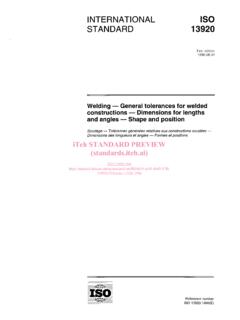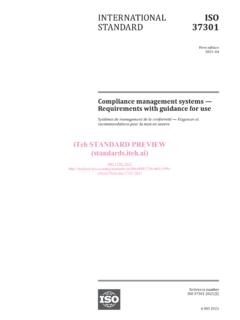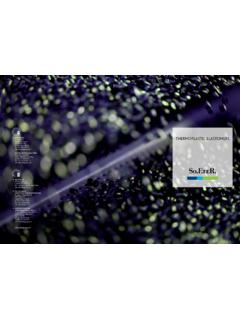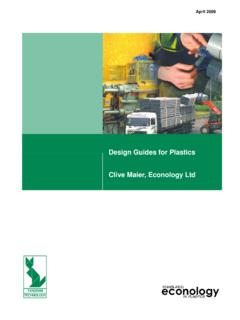Transcription of INTERNATIONAL ISO STANDARD 20457
1 ISO 2018 plastics moulded parts Tolerances and acceptance conditionsMoulages plastiques Tol rances et conditions de r ceptionINTERNATIONAL STANDAR DISO20457 First edition2018-09 Reference numberISO 20457 :2018(E)iTeh STANDARD PREVIEW( )ISO 20457 :2018 ISO 20457 :2018(E) ii ISO 2018 All rights reservedCOPYRIGHT PROTECTED DOCUMENT ISO 2018 All rights reserved. Unless otherwise specified, or required in the context of its implementation, no part of this publication may be reproduced or utilized otherwise in any form or by any means, electronic or mechanical, including photocopying, or posting on the internet or an intranet, without prior written permission. Permission can be requested from either ISO at the address below or ISO s member body in the country of the copyright officeCP 401 Ch.
2 De Blandonnet 8CH-1214 Vernier, GenevaPhone: +41 22 749 01 11 Fax: +41 22 749 09 47 Email: in SwitzerlandiTeh STANDARD PREVIEW( )ISO 20457 :2018 ISO 20457 :2018(E) Foreword ..ivIntroduction ..v1 Scope ..12 Normative references ..13 Terms and definitions ..14 Symbols and abbreviated terms .. General .. Symbols .. Abbreviated terms ..35 Tolerancing of plastic moulded parts .. General .. Intention .. General tolerances .. Direct tolerancing (individual tolerancing) .. Tolerancing of draft angles .. Dimensioning, tolerancing and measuring of radii .. Specification of freeform surfaces ..66 Moulding compound properties .. General .. Moulding shrinkage and shrinkage anisotropies.
3 moulded material stiffness or Dimensional and geometrical tolerancing .. Dimensional Tolerance grades for features of sizes .. Determination of the tolerance grades .. Geometrical tolerancing .. Parting line/Tool offset .. Tolerancing of angular dimensions ..178 Acceptance conditions for moulded part production (ABF) ..17 Annex A (informative) Dimensional reference levels for application and production of the moulded parts ..18 Annex B (informative) Causes and influential factors on the moulding shrinkage of non-porous plastics ..20 Annex C (informative) Evaluation of the production expense ..21 Annex D (informative) Validation of machine or process capability ..24 Annex E (informative) Main causes for dimension, form and location deviations in moulded part production.
4 25 Annex F (informative) Example for determining the DP dimension for application of Table 9 ..26 Annex G (informative) Feasible acceptance parameters ..27 Bibliography ..28 ISO 2018 All rights reserved iiiContents PageiTeh STANDARD PREVIEW( )ISO 20457 :2018 ISO 20457 :2018(E)ForewordISO (the INTERNATIONAL Organization for Standardization) is a worldwide federation of national standards bodies (ISO member bodies). The work of preparing INTERNATIONAL Standards is normally carried out through ISO technical committees. Each member body interested in a subject for which a technical committee has been established has the right to be represented on that committee. INTERNATIONAL organizations, governmental and non-governmental, in liaison with ISO, also take part in the work.
5 ISO collaborates closely with the INTERNATIONAL Electrotechnical Commission (IEC) on all matters of electrotechnical standardization. The procedures used to develop this document and those intended for its further maintenance are described in the ISO/IEC Directives, Part 1. In particular, the different approval criteria needed for the different types of ISO documents should be noted. This document was drafted in accordance with the editorial rules of the ISO/IEC Directives, Part 2 (see www .iso .org/directives).Attention is drawn to the possibility that some of the elements of this document may be the subject of patent rights. ISO shall not be held responsible for identifying any or all such patent rights. Details of any patent rights identified during the development of the document will be in the Introduction and/or on the ISO list of patent declarations received (see www.)
6 Iso .org/patents).Any trade name used in this document is information given for the convenience of users and does not constitute an endorsement. For an explanation of the voluntary nature of standards, the meaning of ISO specific terms and expressions related to conformity assessment, as well as information about ISO's adherence to the World Trade Organization (WTO) principles in the Technical Barriers to Trade (TBT) see www .iso .org/iso/foreword . document was prepared by Technical Committee ISO/TC 61, feedback or questions on this document should be directed to the user s national standards body. A complete listing of these bodies can be found at www .iso .org/members .html. iv ISO 2018 All rights reservediTeh STANDARD PREVIEW( )ISO 20457 :2018 ISO 20457 :2018(E)IntroductionIn comparison to metal materials, significantly larger deviations with respect to dimension, form and location are expected when manufacturing moulded parts.
7 Based on particular properties, such as high deformability and low stiffness, the functional accuracy requirements in order to economically manufacture moulded parts are much lower for plastics than for physical and chemical properties as well as the material modification options of plastics are vastly different from those of metals. Properties of plastics relevant to dimensional accuracy in the moulding application and during processing by the original mould method ( injection moulding, compression moulding, rotational moulding) require a different evaluation and quantification of geometrical tolerances in comparison to metal materials. The tolerance standards applicable for metal parts, therefore, cannot be adopted for plastic structures or can only be applied to a very limited extent which led to the development of this unique properties of plastics mean that three different dimensional reference levels defined in Annex A and characterized in respect to the main influential factors are taken into following is the preferred sequence of steps to ensure effective cooperation in the effective design and development of moulded ) The part designer specifies the functionally required tolerances based on the application requirements including, part functionality, use environment, and any assembly )
8 The moulded part manufacturer confirms that the functionally required tolerance is greater than or equal to the tolerance capability of the manufacturing technology to be used. This is to avoid impractical tolerances which cannot be achieved without incurring adverse economic or productivity effects. The functionally required tolerances should always be defined in the design ) The functionally required tolerances should always be defined in the design documentation in order to establish the basis for determining the moulding shrinkage. This is to prevent situations in which the functionally required tolerances cannot be achieved, if at all, without excessive scrap generation and excessive cost. After order placement, calculated values with respect to the moulding shrinkage should be agreed between the part manufacturer and toolmaker or tool designer, with consultation with the material supplier as control of the moulded part is primarily affected by the material specified, the part design and tool layout, and the processing addition to the factors affecting dimensional control, there are other factors which influence dimensions, part integrity and mechanical properties.
9 These factors include anisotropic behaviour, warpage and distortion due to non-uniform thicknesses and resulting non-uniform cooling rates, and fill profiles. These factors and the basic complexity of polymer systems make standardization much more difficult in comparison to conventional materials such as of the unavoidable process-induced factors, deviations are therefore expected in the moulded part. The procedure in case of deviations depends on the function of the moulded part and is subject to mandatory contractual agreement. eliminate deviation by design measures (strengthening ribs, optimized material thickness, optimized fill profiles, etc.); correct deviation by specified retention in the tool, extended cooling cycles; acceptance of non-conformance.
10 ISO 2018 All rights reserved viTeh STANDARD PREVIEW( )ISO 20457 :2018 ISO 20457 :2018(E)The acceptance of non-conformance requires appropriate documentations including drawing corrections, production deviation documentations or updated reference 1 Process-induced deviations can be reduced both by effective design of the moulded part and by optimization of the production 2 The conventional tolerance chain calculation presupposes rigid bodies and is therefore primarily unsuitable for plastic parts. vi ISO 2018 All rights reservediTeh STANDARD PREVIEW( )ISO 20457 :2018 INTERNATIONAL STANDARD ISO 20457 :2018(E) plastics moulded parts Tolerances and acceptance conditions1 ScopeThis document specifies possible manufacturing tolerances for plastic moulded document specifies all integral features with general tolerances with surface profile tolerance within a specified datum system.












